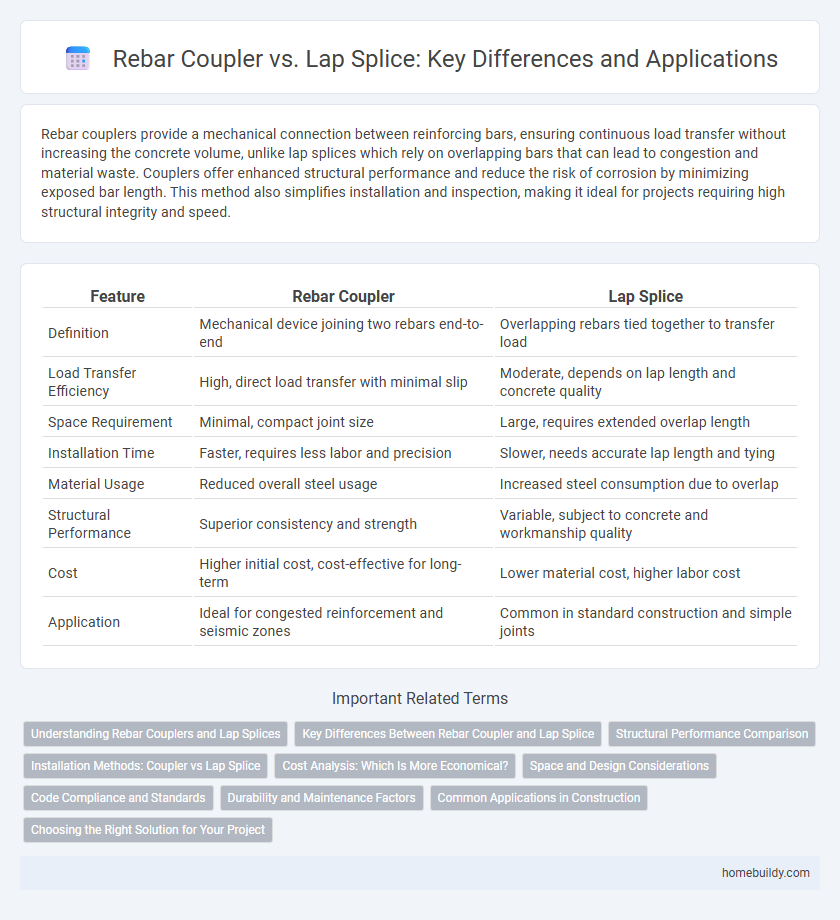Rebar couplers provide a mechanical connection between reinforcing bars, ensuring continuous load transfer without increasing the concrete volume, unlike lap splices which rely on overlapping bars that can lead to congestion and material waste. Couplers offer enhanced structural performance and reduce the risk of corrosion by minimizing exposed bar length. This method also simplifies installation and inspection, making it ideal for projects requiring high structural integrity and speed.
Table of Comparison
| Feature | Rebar Coupler | Lap Splice |
|---|---|---|
| Definition | Mechanical device joining two rebars end-to-end | Overlapping rebars tied together to transfer load |
| Load Transfer Efficiency | High, direct load transfer with minimal slip | Moderate, depends on lap length and concrete quality |
| Space Requirement | Minimal, compact joint size | Large, requires extended overlap length |
| Installation Time | Faster, requires less labor and precision | Slower, needs accurate lap length and tying |
| Material Usage | Reduced overall steel usage | Increased steel consumption due to overlap |
| Structural Performance | Superior consistency and strength | Variable, subject to concrete and workmanship quality |
| Cost | Higher initial cost, cost-effective for long-term | Lower material cost, higher labor cost |
| Application | Ideal for congested reinforcement and seismic zones | Common in standard construction and simple joints |
Understanding Rebar Couplers and Lap Splices
Rebar couplers provide a mechanical connection between two steel bars, ensuring structural integrity by transmitting load efficiently without increasing the rebar congestion typically seen in lap splices. Lap splices overlap two rebars for a specific length to transfer stress through bond and friction, which can lead to larger concrete sections and potential congestion issues. Comparing these methods highlights couplers' advantages in reducing material usage and improving load transfer consistency in reinforced concrete construction.
Key Differences Between Rebar Coupler and Lap Splice
Rebar couplers connect steel bars end-to-end mechanically, providing a direct, high-strength joint that reduces congestion and material waste. Lap splices overlap steel bars for a length that ensures load transfer through concrete bonding but require longer development lengths and can increase concrete congestion. Key differences include coupling efficiency, installation time, material savings, and structural performance, with couplers offering superior load transfer and reduced beam size requirements.
Structural Performance Comparison
Rebar couplers offer superior structural performance compared to lap splices by providing a direct mechanical connection that ensures continuous load transfer and reduces stress concentrations. Unlike lap splices, which rely on overlapping lengths of rebar and can lead to reduced effective area and potential slip, couplers maintain the original cross-sectional strength and enhance joint reliability under tension and shear forces. This results in improved durability, reduced material usage, and more efficient structural integrity in reinforced concrete applications.
Installation Methods: Coupler vs Lap Splice
Rebar coupler installation involves mechanically joining two bars by threading or welding, offering a faster and more precise connection with minimal space requirements. Lap splice installation requires overlapping the bars by a specified length and tying them together, often demanding more labor and increased concrete cover for structural integrity. Couplers reduce material overlap and congestion, improving constructability in confined areas compared to the traditional lap splice method.
Cost Analysis: Which Is More Economical?
Rebar couplers generally offer a more economical solution than lap splices by reducing steel consumption and minimizing labor costs associated with overlapping bars and congestion. Though initial material costs for couplers may be higher, the overall savings from decreased material waste, faster installation, and improved structural efficiency often result in lower total project expenses. Cost analysis favors coupler use in large projects where labor and material efficiency significantly impact the budget.
Space and Design Considerations
Rebar couplers significantly reduce the required lap length, saving valuable space in congested structural designs and enhancing reinforcement continuity. Unlike lap splices that demand overlapping bars and increased rebar congestion, couplers provide a mechanical connection that streamlines construction and improves load transfer efficiency. Space optimization through couplers allows for thinner concrete sections and more flexible architectural layouts, crucial in high-density urban projects.
Code Compliance and Standards
Rebar couplers provide a code-compliant alternative to traditional lap splices by meeting standards such as ACI 318 and ASTM A1081, ensuring reliable tension transfer and structural integrity. Couplers reduce congestion and material waste while maintaining compliance with seismic design criteria outlined in standards like AISC 341. Lap splices, governed by prescribed length requirements in codes like ACI 318, are often more conservative but may lead to increased congestion and potential construction challenges.
Durability and Maintenance Factors
Rebar couplers provide superior durability compared to lap splices by eliminating cold joints and ensuring a continuous load path, reducing the risk of corrosion and structural weakness over time. Maintenance requirements for couplers are typically lower since they minimize concrete cover disturbances, unlike lap splices which can create congestion and potential stress points that may require more frequent inspection and repair. The enhanced structural integrity offered by rebar couplers leads to longer-lasting reinforcement systems with reduced lifecycle maintenance costs.
Common Applications in Construction
Rebar couplers are commonly used in high-rise buildings, bridges, and precast concrete structures where precise alignment and load transfer are critical. Lap splices are typically applied in conventional reinforced concrete construction such as slabs, beams, and columns where overlapping bars provide sufficient strength. Both methods ensure structural integrity, but couplers offer a cleaner, more space-efficient connection ideal for congested reinforcement areas.
Choosing the Right Solution for Your Project
Rebar couplers provide a mechanical connection that ensures full load transfer and reduce congestion in reinforced concrete structures, making them ideal for high-strength and space-limited projects. Lap splicing, involving overlapping rebar lengths, is simpler and cost-effective but demands longer development lengths and can lead to congestion, affecting concrete flow and structural integrity. Selecting between rebar couplers and lap splices depends on project-specific factors such as load requirements, available space, construction speed, and overall cost efficiency.
Rebar Coupler vs Lap Splice Infographic

 homebuildy.com
homebuildy.com